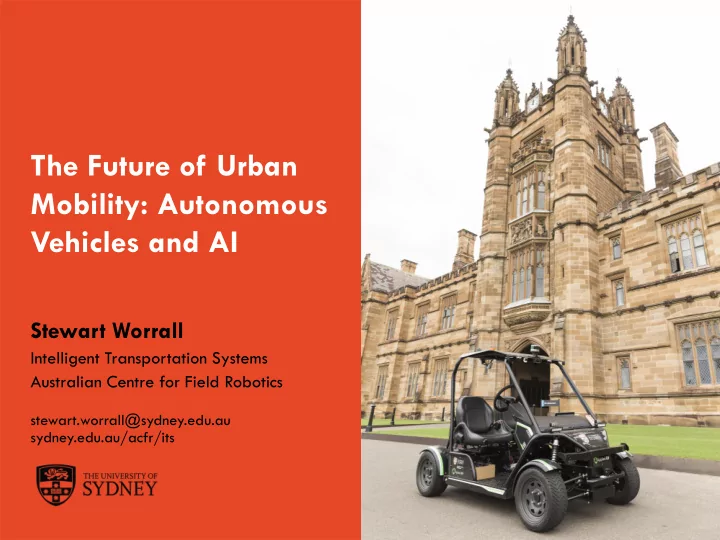

The Future of Urban Mobility: Autonomous Vehicles and AI Stewart Worrall Intelligent Transportation Systems Australian Centre for Field Robotics stewart.worrall@sydney.edu.au sydney.edu.au/acfr/its The University of Sydney Page 1
Imagine the Future – the promise of automation The University of Sydney Page 2
Our vision – last mile transport The University of Sydney Page 3
Precinct scale transport on demand University Campus Olympic Park Construction Sites Retirement Villages The University of Sydney Page 4
ACFR-ITS: Connected Autonomous vehicles The University of Sydney Page 5
Modular platform design The University of Sydney Page 6
How to make an autonomous vehicle Part 1 : Where am I? Where am I going? How do I get there? The University of Sydney Page 7
How to make an autonomous vehicle Part 2 : Who/What is around me? Where can I safely move? Range The University of Sydney Page 8
How to make an autonomous vehicle Part 3 : How do things behave? Where is everyone else going? The University of Sydney Page 9
How to make an autonomous vehicle Part 4 : Move !..... without hitting anything of course The University of Sydney Page 10
Why don't we have autonomous vehicles yet? uncertainty in measurement, classification unpredictability drivers, pedestrians, cyclists, etc unobservable hidden variables (attention, capability, etc) partial obstructions The University of Sydney Page 11
Why don't we have autonomous vehicles yet? Sensor advantages/disadvantages noise, weather, context, partial observations The University of Sydney Page 12
Low dimensional problems Certain tasks are well understood – Engineering solution: motion model/uncertainty – Robust through sensor fusion – Explainable, testable and verifiable The University of Sydney Page 13
High dimensional problems There are millions of variables in a typical urban scene e.g. behaviour of a pedestrian/driver can be influenced by – Paying attention (or not) – Talking with friends – Old, young, disabled – Drunk/drugged/tired – In a hurry – Local/tourist – Many many more Human brains are good at this Many are not directly observable The University of Sydney Page 14
Detecting a child next to the road – context is important The University of Sydney Page 15
Predicting the future is hard The main challenge in autonomous driving is to predict the future Problem 1 : Classification of objects is hard and presents uncertainty Problem 2 : Predicting what people/objects will do in the future is very hard and presents even more uncertainty Both are very high dimensional problems that have not been solved using traditional approaches The University of Sydney Page 16
Data driven approach Step 1: Record examples of every possible type of object, or scenario Step 2: Select an appropriate machine learning technique Step 3: Training and cross validation Basically, it is a magic black box that is difficult to explain The University of Sydney Page 17
CNN: Detecting a vehicle - KITTI benchmark The University of Sydney Page 18
CNN: Detecting a pedestrian – KITTI benchmark The University of Sydney Page 19
RNN: predicting vehicle trajectories in intersections Built using 23000 vehicle trajectories The movement of vehicles through an intersection is like a language that as humans we learn to read over many years. The University of Sydney Page 20
So this is a solved problem then ? Edge case scenarios? Explainable? Statistically correct? 90% is hard, 99% is very hard, ..... what is good enough? The University of Sydney Page 21
So where from here? Remember, lives are at stake - people need to sign off on this – Safety drivers – Restricted domains (highways, good weather, low speed) – Slowly introduce new domains – Convince people/insurers/governments/investors The University of Sydney Page 22
Thank you! The University of Sydney Page 23
Recommend
More recommend